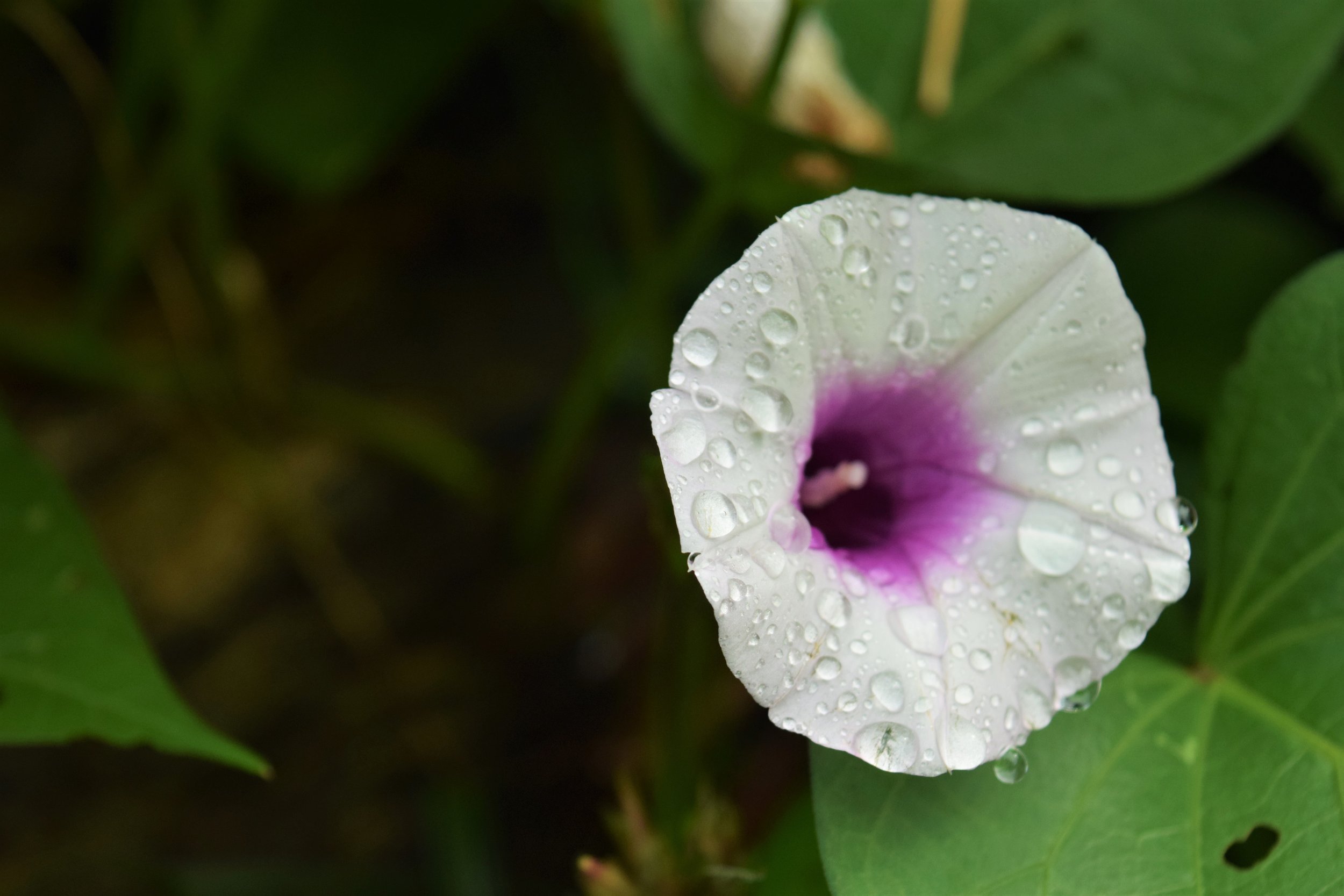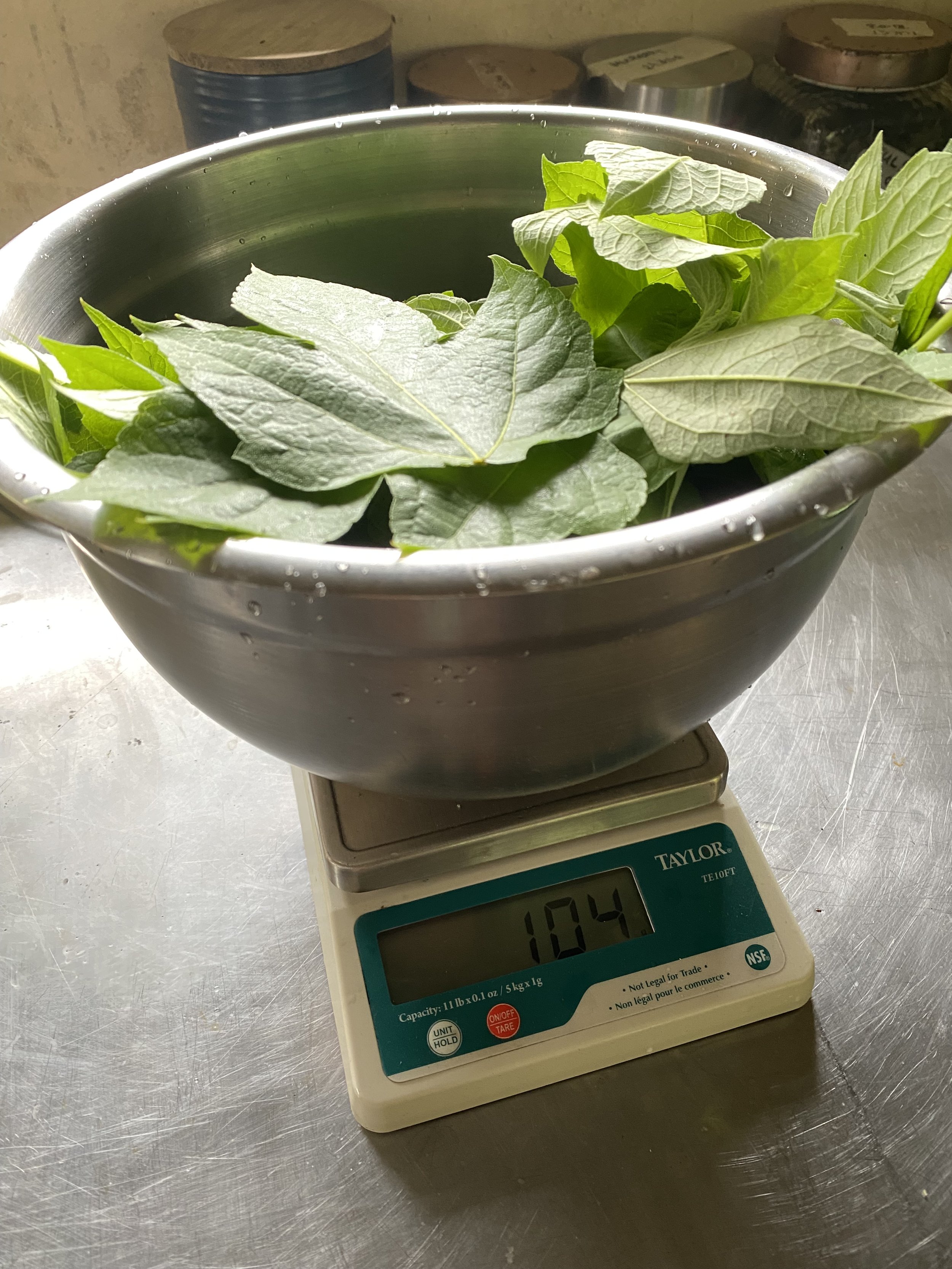Fermented Plant Juice (FPJ) and Its Application
By Connor Gilmartin, apprentice 2022
Earlier this year, I wrote a short article on preparing a garden amendment called Water Soluble Calcium (WCA). That short essay focused on how to make small batches of WCA in the comfort of your home using discarded eggshells and vinegar. Water Soluble Calcium is one of the five pillars of Korean Natural Farming (KNF). The remaining four recipes KNF methodology encourages us to utilize are Lactic Acid Bacteria (LAB), Fermented Plant Juice (FPJ), Oriental Herbal Nutrient (OHN) and Fish Amino Acid (FAA). Because this article won’t cover the remaining three ferments in-depth, I highly recommend looking into the University of Hawaii’s College of Tropical Agriculture’s papers on this subject. The authors of those articles do a great job at explaining the process of making and applying these homemade amendments. These KNF ferments we’re talking about have a symbiotic relationship with one another. Generally speaking, they serve your garden’s needs best in the presence of each other – especially when they’re used to inoculate biochar or indigenous microorganism (IMO) culture.
It’s worth mentioning the obvious here - everyone’s gardening environment is completely unique, and every soil system has different nutritional requirements. For the sake of brevity, it’s necessary to generalize a bit. If you’re interested in diving deeper into soil science and plant nutrient uptake, I would highly recommend Jeff Lowenfels’s books Teaming with Microbes and Teaming with Nutrients, as well as Steve Solomon’s The Intelligent Gardener.
I chose to write my first article for Rancho Mastatal on Water Soluble Calcium simply because of the abundance of eggshells we have here, and our robust supply of homemade vinegars. While Calcium is an essential macronutrient in plant growth and fruit development, it is only one piece – albeit a very important piece - of the puzzle of plant nutrient uptake. So, with that being said, lets learn about another pillar of Korean Natural Farming, Fermented Plant Juice (FPJ).
“Growth is controlled not by the total amount of resources available, but by the scarcest resource.”
Before we learn about FPJ’s, dynamic accumulators, and the fundamentals of fermentation, I want to ramble about Justus Von Liebig’s Law of the Minimum - a very important concept in regard to plant nutrient uptake. Liebig’s law states, “Growth is controlled not by the total amount of resources available, but by the scarcest resource.” This is particularly relevant when trying to rebalance minerals and macronutrients in your soil. In, Teaming with Nutrients, Jeff Lowenfels discusses the Law of the Minimum and writes, “plant growth is limited by the least abundant mineral, no matter how abundant the other minerals happen to be.” So, with that in mind, we can make more informed decisions when choosing how to fertilize our gardens.
Before we fertilize at all, a soil test is probably in order. The informed gardener understands that N-P-K listings on commercially available fertilizers only account for three of the seventeen elements necessary for plant life. Many of us have been tricked into thinking Nitrogen, Phosphorus and Potassium are the only elements we need to consider when fertilizing our soil. This couldn’t be farther from the case, and has resulted in massive amounts of excess nutrients polluting our watersheds and harming aquatic life essential in maintaining Earth’s homeostasis. I am a firm believer in a balanced approach to gardening, and certainly don’t believe all bagged fertilizers and amendments are the devil’s work. There are amazing, conscious companies that specialize in producing ethically sourced organic fertilizers. I have purchased bulk earthworm castings, mycorrhizal inoculants, crustacean meals, bokashi grain blends, and many more amendments that did not come from my garden. Does this violate Albert Howards’s Law of Return? Certainly. I am importing ingredients from hundreds, maybe thousands of miles away into my garden’s soil. The very nature of gardening for consumption violates the law of return. This is okay – gardening is a dynamic process, yields can be achieved and measured in many ways. As Masanobu Fukuoka writes in One Straw Revolution,
“It doesn’t matter how the harvest will come out. Just sow seeds and care tenderly for the plants and soil… The ultimate goal of farming is not the growing of crops but the cultivation and perfection of human beings.”
I learn something every season I germinate seeds. I feel an overwhelming sense of satisfaction and joy when I feed my plants a nutrient-rich tea, or spread a cover crop on a resting hugelmound. Maybe these more philosophical “yields” are really what I crave… Who am I kidding – I also want massive, nutrient-dense broccoli, that I can brag about – and share – with my neighbors. Point in case, there are many ways to address fertilization requirements in the garden. I’m not a devotee of any gardening guru, and I’m not advocating for any one specific strategy. I’m interested in holistic plant and soil stewardship that integrates many approaches.
Now, lets get down to business. FPJ’s are made using two simple ingredients. Chopped up biomass and brown sugar. There are a whole lot of plant species that can be used to make FPJ’s. I’ve used the young, vigorously growing tips of mugwort, comfrey, stinging nettle, wormwood, tulsi, and Mexican sunflower to name a few. I’ve also used unripe persimmons, pumpkins, and other fruits and vegetables to make Fermented Fruit Juice (FFJ). There are a whole lot of individual plant species and combinations that experienced horticulturalists have found to be beneficial in their gardens. It’s been observed that certain plants have a tendency to accumulate one macronutrient more than others. In the Korean Natural Farming and biodynamic gardening community, these plants are generally referred to as, “dynamic accumulators.” The concept of dynamic accumulators is a bit contentious, and some people doubt the idea. To be fully transparent, I do not know enough to say with 100% certainty that certain plant species have an affinity to accumulate one macronutrient over the other. However, I’ve visited many extremely productive, beautiful garden spaces whose caretakers embrace this idea, and it certainly doesn’t seem to be hurting anything. I will leave this entirely up to you to decide for yourself. Horsetail (Lorim ipsum) is known to have a high concentration of silica in its stalky biomass. Bamboo shoot FPJ is known to contain high amounts of nitrogen. FfJ made from young, unripe fruit can contain high amounts of phosphorous. With mindful intervention, we can amplify the nutritional impact these biomasses have on our garden by utilizing the friendly yeasts and other microorganisms drifting about. By feeding the microorganisms that reside on the biomass of these plants organic brown sugar, we catalyze the process of fermentation. The weak alcohol that is produced by the yeast as they nibble on the sugar we’ve so graciously provided them extracts chlorophyl from the biomass and other ethanol-soluble compounds contained in the plants via the process of osmosis. These compounds are called phytochemicals. The following section will cover the materials needed and list the step-by-step process to produce and apply FPJ.
Materials
I’ll begin by listing the materials you’ll need to make a batch of Fermented Plant Juice (FPJ). They are as follows:
Glass jar or food-grade plastic container
A sharp, clean knife to chop up the biomass
Organic brown sugar
A breathable cloth to act as a “lid” (cheesecloth or nut milk bags work quite well)
How To Prepare a batch of FPJ
Collect plant material
It is ideal to harvest the biomass before sunrise. Cut the young, vigorously growing tips of your desired plant and store in a clean container
Harvesting before sunrise ensures the plants are in respiration-mode, not photosynthesis-mode
Avoid collecting biomass during or after a heavy rain event
Cut and weigh the plant material
Do not rinse collected plant parts, to conserve surface microorganisms
Record weight of biomass
Add brown sugar
1:1 (brown sugar to biomass) ratio. If you have one pound of comfrey, put in one pound of brown sugar. Coat as much of the surface area of the plant material as possible to encourage the fermentation process
Pack the brown sugar-coated biomass into a fermentation vessel
Pack tightly
Attach breathable lid using string or a rubber band, depending on the size of the fermentation vessel
Store the covered container in a well-ventilated area away from light and extreme heat or cold
Check the container after 24 hours and adjust the volume if necessary
Your fermentation vessel should be no more than 2/3 full. If the container is too full, the microbes will not have enough air to properly ferment.
Let the contents ferment for 4 -7 days
You will know that fermentation is occurring when bubbles start to form in the liquid
Fermentation is complete when the plant material floats and the liquid settles at the bottom, there is a slightly alcoholic smell due to breakdown of chlorophyll and the liquid tastes sweet, not bitter. It is possible that the plant material doesn’t form a distinct layer in the solution, so these are loose guidelines – everyone’s fermentation environment is different. This process is heavily influenced by the ambient temperature of the environment you live in.
Strain the solution
Separate the plant material from the liquid
The spent biomass can be added to compost or mulched directly into your soil
Store the FPJ
Transfer FPJ into a clean ball jar or food grade plastic container
Cover with a loose lid - the microorganisms in the solution are very much alive and will continue to produce carbon dioxide as they consume leftover sugar. This could cause a jar to explode if the lid is on too tight.
How To apply FPJ
Dilute at a ratio of 1:500, 1:800 or 1:1,000. This translates to 4-8ml of FPJ per gallon of water. It’s powerful! You can always add more, you can never add less.
The dilution of 1:800 or 1:1,000 should be used if:
You’re applying a mixture of different amendments (ex. WCA + FPJ + FAA)
You’re applying FPJ in hot weather
FPJ can be applied as a soil drench (diluted in a in a watering can or other water dispersal system) or as a foliar spray. Apply the solution once a week or so, no more than once a week. Try and apply FPJ’s that were prepared using biomass that was collected at a similar stage of the plant’s growth cycle to the ones you’re feeding. For example, use a light dilution of young mugwort FPJ for young plants, and use an FFJ of unripe, green fruit when those plants are beginning to enter their reproductive stage of development.
Korean Natural Farming is a dynamic process that requires familiarization with the unique terroir of your gardening environment. Just like baking sourdough or making kombucha, preparing KNF amendments might require some trial and error. I feel inclined to repeat – “dilution is the solution.” These ferments are highly concentrated. Apply wisely, consciously, and out of direct sunlight. Take your time, enjoy the process, and revel in the beneficial microorganisms you’re stewarding.
Learning how to prepare these ferments will not only add macronutrients to your soil system but will increase the bioavailability of preexisting nutrients in your soil. Gardening really boils down to being a soil steward, which basically means we’re ranching microorganisms. Imagine yourself as a benevolent god, feeding trillions of beneficial soil macro and microbiota for the betterment of the world. Your plants will thank you.
Happy gardening, mulch love.
Connor can be contacted via email with any questions or professional inquires (connorjgilmartin@gmail.com).
“I sometimes think that never blows so red
The rose as where some buried Caesar bled;
That every Hyacinth the garden wears
Dropt in her lap from some once lovely head”






